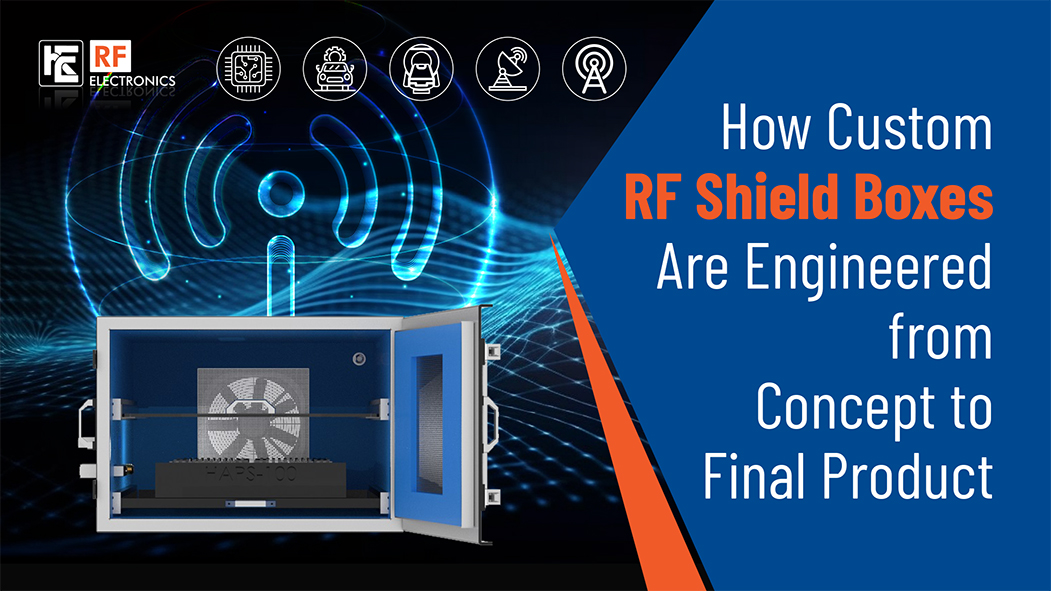
As electric vehicles (EVs) become an everyday sight, the infrastructure supporting them must stay a step ahead—especially in terms of clean, interference free charging. One crucial piece of this puzzle is radio frequency (RF) shielding. Below, we explore why RF shielding matters in EV charging stations and how RF Electronics delivers the right solutions.
1. Why RF shielding matters at charging stations
EV charging stations involve power electronics that communicate via Wi Fi, Bluetooth, cellular, and vehicle to grid (V2G) systems. Without proper shielding, these systems can suffer from electromagnetic interference (EMI). That interference can lead to unreliable data transfer, incorrect charging reports, or even equipment failure.
RF shielding—which essentially forms a Faraday cage—prevents stray radio waves from disrupting sensitive electronics. In an EV station, that means cleaner signals, stronger wireless links, and fewer errors during charging or billing.
2. EV charging use cases that depend on clean RF
- Vehicle-to-Grid and smart load balancing: With V2G, EVs talk to the grid to report battery state or request charge. EMI can garble those radios, delaying firmware updates or energy trade.
- Payments and authentication: Station-side apps, QR scanners, RFID, or NFC rely on wireless accuracy. Shielding ensures clear connections and correct billing.
- Remote monitoring & maintenance: Modern chargers broadcast performance metrics and firmware updates over cellular or Wi Fi. Clean RF links boost uptime and ease troubleshooting.
- Safety systems: Sensors in high-voltage enclosures may rely on wireless links to safety interlocks. RF noise could impede emergency responses.
3. How RF Electronics helps with next-gen EV charging
RF Electronics manufactures a variety of RF shielded enclosures suited to EV infrastructure:
- Benchtop and stand alone shield boxes: These compact housings—ideal for prototyping and lab use—offer reliable RF isolation for chargers-in-progress.
- Rack mount shield boxes: Solutions like the HDRF 1570 AM bring lab performance into field racks. With >130?dB isolation from 20?MHz to 1?GHz and solid performance through 12?GHz, they ensure controller boards and meters stay interference free.
- Shield boxes with turn tables: These units allow rotating devices under test—as in OTA testing—inside fully enclosed, shielded boxes, which is handy when evaluating directional antennas in charger hardware.
- Rack mount kits: RF Electronics offers rack-ready shield solutions integrated into full test systems, perfect for high volume station testing or production setups.
All enclosures feature thick foam absorbers, filtered power inputs, and flexible connector options—supporting Bluetooth, Wi Fi, 3G, LTE, 5G, RFID, GPS.
4. What RF shielding brings to your EV charging system
- Better reliability: By blocking unwanted RF, chargers deliver clean signals for communication, authentication, and safety.
- Regulatory compliance: Outdoor stations must adhere to EMI limits to protect nearby avionics, medical devices, and communication systems. Using shielded enclosures supports EMC testing and compliance.
- Faster development cycles: Engineers can test vibration mounted chargers or prototype modules inside shield boxes for real time performance without moving vehicles on-site.
- Easier maintenance: Shielded enclosures provide predictable connectivity during diagnostics and firmware updates—vital for fleets and public infrastructure.
5. Setting up RF shielding in real world stations
- Integrate during design: Plan shielded enclosures for high interference sub systems like power converters or wireless modules.
- Choose the right form factor: Benchtop units support early experimentation, standalone units aid compact hardware integration, and rack units suit production or field racks.
- Keep connectors flexible: RF Electronics supports cables, filters, power inputs, and custom ports—helping you avoid EMI leakage.
- Verify with EMC testing: Use RF Electronics shield boxes and anechoic chambers for OTA and EMC testing. Their chambers mimic real world conditions in a controlled way.
6. Future ready EV infrastructure
Charging networks are evolving fast, with features like ultra fast charging, edge AI, intelligent balancing, and wireless charging poised to become mainstream. RF density at charging hubs will rise, and so will EMI risk.
Investing in RF shield enclosures early ensures:
- Scalability: Add high frequency wireless gear without compromising.
- Robustness: Future waves like 6?GHz Wi Fi, Wi Fi 7, C V2X, and 5?GHZ V2X stay clear of interference.
- Cost efficiency: Pre validated shielding saves re delivery, re testing, and site tuning.
Conclusion
As EV charging networks grow, making them future proof relies on interference clear, secure wireless signalling. RF shielding is a backbone technology for reliable charging, rapid updates, and station safety.
RF Electronics offers the solutions—benchtop, rack, standalone, and chambers—needed for clean, certifiable EV charging. Integrate RF shielding early in your design, avoid mis behaviour from EMI, and accelerate to market with confidence.
Contact RF Electronics today for a custom RF shield enclosure or advice on EMI safe EV station design.


